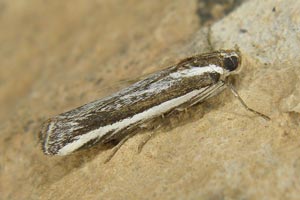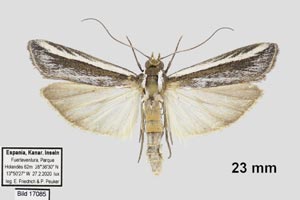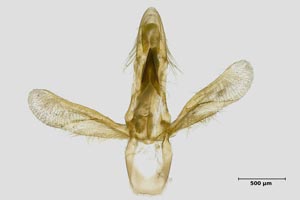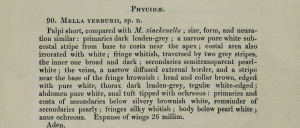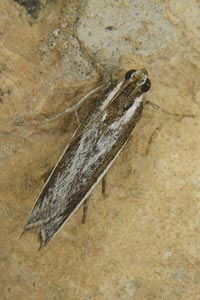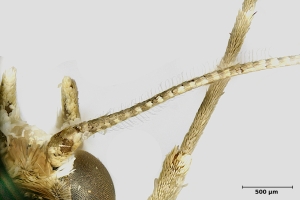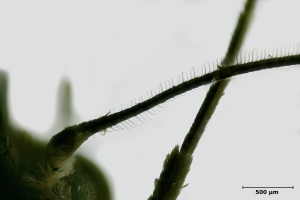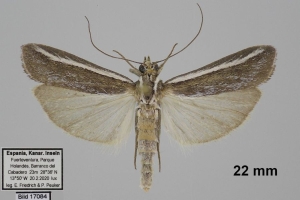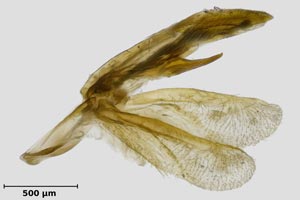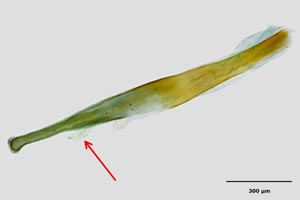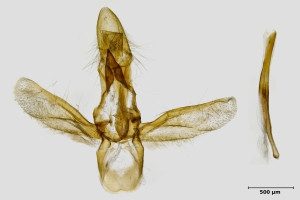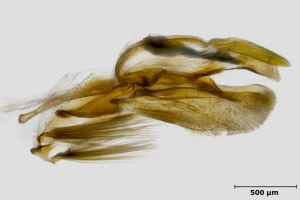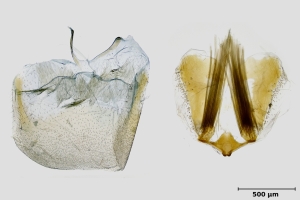

 +11Kontinente:EUASAF
+11Kontinente:EUASAF1. Lebendfotos
1.1. Falter
2. Diagnose
2.1. Männchen
2.2. Genitalien
2.2.1. Männchen
2.3. Erstbeschreibung
3. Weitere Informationen
3.1. Andere Kombinationen
- Mella yerburii Butler, 1884 [Originalkombination]
- Staudingeria yerburii (Butler, 1884)
3.2. Synonyme
- Heterographis costalbella Mabille, 1906
- Ancylosis costalbella (Mabille, 1906)
3.3. Taxonomie und Faunistik
Die Art wurde aus der Umgebung von Aden im Jemen beschrieben. Sie wurde sowohl für die Kanaren als auch für Zypern und die Balearen (Ibiza [siehe Férriz et al. (2006)]) angeführt. Grund dafür war die Subsummierung von Ancylosis labeculella unter diesen Namen, die sich nach Leraut (2014: 415) als falsch herausgestellt hat. Für Zypern ist das Vorkommen von Ancylosis labeculella mittlerweile abgesichert, für die Kanaren scheint es noch zu überprüfen zu sein. Für ein Vorkommen von A. yerburii in Europa fehlte lange Zeit ein konkreter Nachweis. Leraut (2014) schreibt zum Verbreitungsgebiet: "Presence in Europe uncertain (hitherto confused with the following species); North Africa (Morocco, Algeria, Tunisia), Middle East". Erst Bidzilya et al. (2020: 479) können über ein Vorkommen im europäischen Teil von Russland nördlich von Astrachan etwas östlich der Wolga berichten: "Russia: 12 ♂, 1 ♀, Astrakhan region, Khosheutovo vill. 23 km NE, 47°10’11’’, 48°02’50’’, 17.v.2017 (ET)." Sie schreiben zur Gesamtverbreitung: "Algeria, Tunisia, Libya, Egypt, Yemen, Iran (Roseler 1973 [sic, recte: Roesler; im Literaturverzeichnis Seite 480 ist der Autor korrekt zitiert]; Leraut 2014), Kazakhstan (first record), Russia (Astrakhan region) (first record)."
Bidzilya et al. (2020: 479) beschreiben die Art etwas detaillierter, vermerken aber auch, dass es hier durchaus noch Klärungsbedarf gibt: "Mella yerburii was described based on unspecified number of specimens from Aden. The female labelled as “type” from NHM should most likely be considered as a lectotype. The current diagnosis of A. yerburii is based on specimens from Northern Africa and Iran externally similar to the type specimen. However, this diagnosis is rather provisional until the genitalia of the type specimen remain unexamined and additional material from type locality is unavailable."
(Autor: Erwin Rennwald)
3.4. Literatur
- Barton, I. (2018): A second contribution to the Lepidopteran fauna of Cyprus, presenting records for 48 taxa from 17 families. — Entomologist’s Record and Journal of Variation 130: 29-39.
- Bidzilya, O., Budashkin, Y., Slamka, F., Tsvetkov, E. & V. Yepishin (2020): Notes on taxonomy and distribution of some Palaearctic Ancylosis Zeller, 1839 (Lepidoptera: Pyralidae: Phycitinae). — Zootaxa, 4822 (4): 451–481.
- Erstbeschreibung: Butler, A. G. (1884): On a Collection of Lepidoptera made my Major J. W. Yerbury at or near Aden. — Proceedings of the scientific meetings of the Zoological Society of London for the Year 1884: 478-503, pl. XLVI.
- Férriz, I., Honey, M.R. & N.J. Riddiford (2006): Els Heterocers del parc natural de ses 199 Salines d'Eivissa i Formentera,(Illes Balears). The Heterocera of the Natural parc of ses Salines d'Eivissa and Formentera (Balearic Islands). — Bolletí de la Societat d'Història Natural de les Balears, 49: 199-211. [PDF auf ibdigital.uib.cat]
- Leraut, P. (2014): Moths of Europe. Volume 4. Pyralids 2. - 441 S.; Verrières-le-Buisson (N.A.P Editions).
- Beschreibung als Heterographis costalbella: Mabille, P. (1906): Essai sur la faune de l'ile d'Oléron. — Annales de la Société entomologique de France 75 (1): 37-56 + pl. 3.
- Ylla, J., Macia, R. & M. Huertas Dionisio (2008): Pirálidos y Crámbidos detectados en Almería, España (Lepidoptera Pyraloidea). — SHILAP Revista de Lepidopterología 36 (142): 191-204. [zur Arbeit auf redalyc.org]












